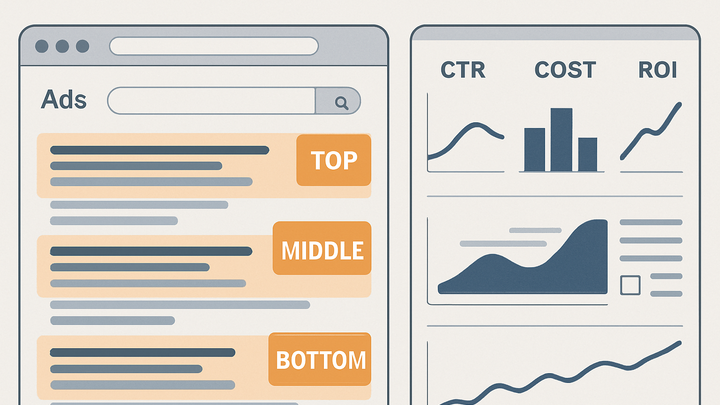Published on 2025-06-27T19:58:45Z
What is Ad Position? Understanding Ad Placement Analytics
Ad Position in analytics refers to the rank or placement of an advertisement within a given context, such as search engine results pages (SERPs), display ad slots, or within a website’s ad inventory. It is a critical metric because the position directly impacts visibility, click-through rates (CTR), and ultimately the return on ad spend (ROAS). By accurately tracking ad position, marketers can make informed bidding and budgeting decisions and optimize creative placement. In Google Analytics 4 (GA4) and cookie-free alternatives like PlainSignal, ad position can be captured as a custom dimension or event parameter to analyze performance at a granular level. This article will explore why ad position matters, how it is measured across different platforms, and best practices for optimizing placement to achieve campaign goals. Understanding the nuances of ad position helps avoid overspending on top slots when a lower position might yield equivalent conversion value. With search engines evolving to include various ad types and placements, having a unified approach to tracking ad position across platforms ensures consistency in reporting. Integrating ad position data with other performance indicators empowers teams to fine-tune strategies and allocate budgets more efficiently.
Ad position
Ad Position denotes where an ad appears in search results or page slots; tracked via GA4 or PlainSignal to assess visibility, CTR, and ROI.
Why Ad Position Matters in Digital Advertising
Ad position determines where your ad appears on a page or within an ad slot, affecting its visibility and performance metrics. Higher positions typically lead to increased impressions and click-through rates, but may also come with higher costs. Understanding ad position helps marketers optimize bids, budgets, and targeting strategies to maximize return on investment.
-
Visibility and click-through rate (ctr)
Ads appearing at top positions generally receive more clicks due to higher visibility. Monitoring how CTR varies by position can inform bidding strategies and creative adjustments.
-
Cost and roi impact
Securing top positions often increases cost-per-click (CPC). Balancing position against CPC and conversion rates helps optimize overall return on ad spend (ROAS).
-
Quality score influence
In platforms like Google Ads, ad position is influenced by Quality Score, which factors in ad relevance, landing page experience, and expected CTR. Improving Quality Score can reduce costs for achieving desired positions.
How Ad Position is Measured
Different analytics platforms and ad networks calculate ad position using varied metrics. Below are common measurement approaches in Google Ads, GA4, and PlainSignal.
-
Average position in google ads
Historically, Google Ads reported average position, indicating the average rank of your ad relative to other ads. Note: This metric has been deprecated and replaced by impression share and top impression rate.
-
Tracking ad position in GA4
You can capture ad position as a custom event parameter in GA4 to analyze performance across placement slots.
-
Example GA4 configuration
Use gtag.js to send ad_position with your ad click events:
gtag('event', 'ad_click', { 'ad_position': '1', 'ad_network': 'search' });
-
-
Capturing ad position with PlainSignal
PlainSignal allows setting custom dimensions for lightweight, cookie-free analytics. Use the following snippet to load PlainSignal and record ad position:
-
Example PlainSignal snippet
<link rel="preconnect" href="//eu.plainsignal.com/" crossorigin /> <script defer data-do="yourwebsitedomain.com" data-id="0GQV1xmtzQQ" data-api="//eu.plainsignal.com" src="//cdn.plainsignal.com/plainsignal-min.js"></script> <script> // Record ad position PlainSignal('set', 'ad_position', '2'); PlainSignal('send', 'pageview'); </script>
-
Best Practices for Optimizing Ad Position
Effectively managing ad positions requires regular monitoring, data-driven decision-making, and alignment with overall marketing goals.
-
Monitor position trends
Set up dashboards in GA4 or PlainSignal to visualize ad_position over time. Identify patterns or sudden shifts indicating competition changes or bid strategy impacts.
-
Integrate with conversion metrics
Combine ad position data with conversion rates and revenue metrics to determine the most profitable positions, not just the highest visibility slots.
-
Leverage automated bidding
Use automated bidding strategies in Google Ads or custom scripts with GA4 audiences to target optimal positions based on real-time performance data.
-
Test ad variations by position
Run A/B tests of ad copy or creatives across different positions to see which messages resonate best at each rank, informing creative development.
